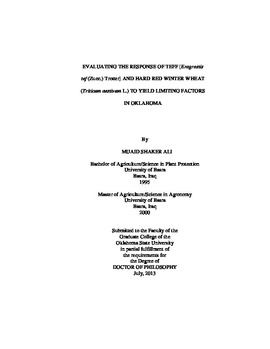| dc.contributor.advisor | Edwards, Jeff | |
| dc.contributor.author | Ali, Muaid Shaker | |
| dc.date.accessioned | 2014-09-24T14:16:48Z | |
| dc.date.available | 2014-09-24T14:16:48Z | |
| dc.date.issued | 2013-07 | |
| dc.identifier.uri | https://hdl.handle.net/11244/10997 | |
| dc.description.abstract | Scope and Method: Weather conditions such as temperature and precipitation are the most important crop growth limiting factors in Oklahoma. Less precipitation is available for crop growth during the summer months due to high evapotranspiration attributed to high temperature. In some years, the winter is dry affecting performance of winter crops. Soil applied phosphate fertilizers use efficiency in winter wheat is low because of soil and weather related factors. Therefore, control and field experiments were established to determine teff growth and yield. The growth chamber teff study comprised three temperature regimes, four levels of soil moisture, three times of watering intervals, and two photoperiods. Treatments for the field study included four levels of irrigation and two watering intervals. Foliar phosphorus improves P use efficiency of crops. However, no effective foliar products are available on the market. The objective of the phosphite study was to evaluate Nutri-phite, a foliar phosphorous product on winter wheat yield, quality and nutrient use efficiency in five fields over two years. Treatments for the foliar P study included application of a Nutri-phite at two growth stages of winter wheat. Nutri-phite was applied with and without N at 100 and 75% of crop need and P at 100 and 80% of P sufficiency a long a check (no fertilizer) and standard (farmer practice) treatments. | |
| dc.description.abstract | Findings and Conclusions: In the control study, teff biomass and grain yields increased with increasing soil moisture and decreased with increasing temperature and photoperiod. Grain yield was more affected by high temperature and drought than biomass yield in the growth chamber study. In the field experiment, biomass and grain yield were highly related to water amount. Teff produced acceptable biomass and grain yields under rainfall treatment. The Nutri-phite product improved grain yield of wheat in some fields, especially when rainfall is not limiting during the growing season. In addition, Nutri-phite was more efficient in increasing grain phosphorus concentration compared with the check treatment. Thus, application of Nutri-phite might improve the wheat growth and yield if weather conditions are normal, and the right amount of Nutri-phite is used. | |
| dc.format | application/pdf | |
| dc.language | en_US | |
| dc.rights | Copyright is held by the author who has granted the Oklahoma State University Library the non-exclusive right to share this material in its institutional repository. Contact Digital Library Services at lib-dls@okstate.edu or 405-744-9161 for the permission policy on the use, reproduction or distribution of this material. | |
| dc.title | Evaluating the response of teff [Eragrostis tef (Zucc.) Trotter] and hard red winter wheat (Triticum aestivum L.) to yield limiting factors in Oklahoma | |
| dc.contributor.committeeMember | Kakani, Gopal | |
| dc.contributor.committeeMember | Desta, Kefyalew Girma | |
| dc.contributor.committeeMember | Anderson, Jeffrey | |
| osu.filename | Ali_okstate_0664D_12829.pdf | |
| osu.accesstype | Open Access | |
| dc.type.genre | Dissertation | |
| dc.type.material | Text | |
| thesis.degree.discipline | Plant Science | |
| thesis.degree.grantor | Oklahoma State University | |
